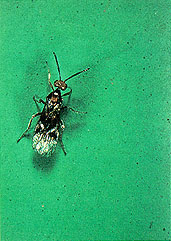
Photo from wikipedia
Abstract Purpose: Insects are known to have higher levels of radiation tolerance than mammals. The fruit fly Drosophila provides opportunities for genetic analysis of radiation tolerance in insects. A knowledge… Click to show full abstract
Abstract Purpose: Insects are known to have higher levels of radiation tolerance than mammals. The fruit fly Drosophila provides opportunities for genetic analysis of radiation tolerance in insects. A knowledge of stage-specific sensitivity is required to understand the mechanisms and test the existing hypothesis of insect radiation tolerance. Materials and methods: Drosophila melanogaster were irradiated using gamma rays at different life stages. Irradiation doses were chosen to start from 100–2200 Gy with increments of 100 Gy, with a dose rate of 12.5 and 25 Gy/min. The threshold of mortality, LD50 and LD100 1 h post-irradiation was recorded for larvae and adults and 24 h post-irradiation for eggs and after 2–3 days for early and late pupae. Total antioxidant capacity for all the life stages was measured using the phosphomolybdenum method. Results: Twenty-four hours post-irradiation, 100% mortality was recorded for eggs at 1000 Gy. One hour post irradiation 100% mortality was recorded at 1300 Gy for first instar larvae, 1700 Gy for second instar larvae, 1900 Gy for feeding third instar larvae and 2200 Gy for non-feeding third instar larvae. Post-irradiation complete failure of emergence (100% mortality) was observed at 130 Gy for early pupae and 1500 Gy for late pupae; 100% mortality was observed at 1500 Gy for adults. The values of LD50 were recorded as 452 Gy for eggs, 1049 Gy for first instar larvae, 1350 Gy for second instar larvae, 1265 Gy for feeding third instar larvae, 1590 Gy for non-feeding third instar larvae, 50 Gy for early pupae, 969 Gy for late pupae, 1228 Gy for adult males and 1250 Gy for adult females. Conclusions: Early pupae were found to be prone to radiation, whereas the non-feeding third instar larvae were most resistant among all stages. The chromosome number being constant and total antioxidant capacity being nearly constant in all stages, we suggest that high rate of cell division during early pupae makes this stage sensitive to radiation.
Journal Title: International Journal of Radiation Biology
Year Published: 2017
Link to full text (if available)
Share on Social Media: Sign Up to like & get
recommendations!